Editor’s Note: The following response/post was inspired by another interesting LinkedIn share by Joël Collin-Demers under the heading: “Standing up a new centralized Procurement department is a tough gig.”
The following excerpt from a June 2007 post talks about decentralization and centralization in procurement – https://bit.ly/40HDpfL
The theory behind the balanced approach is that self-sufficient (usually larger) departments, while independent, will be collaborative partners with the central purchasing group. Specifically, there will be a cross-sharing of critical data, which will result in the best result for the broader organization as a whole. The November 2004 MOU between the State of North Carolina and its Higher Education institutions laid the early groundwork for their approach to a decentralized procurement practice. Conversely, the State of Washington recognized that smaller departments and agencies, whose resources and, therefore, capabilities are more limited, would be more inclined to “coordinate” their purchasing activity through the central procurement office.
In both of the above examples, the hierarchy within each State clearly demonstrated a “desire” (remember Part 4 of this series – Internal & External Collaboration: A Desire versus Skill?) to communicate with a diverse group of key stakeholders to develop a strategy that adapted to the way they operated in the real world. In these, as well as other examples, while a consideration, the software that was in place was of little consequence.
At this very point, a foundational understanding exists, and a consensus has been reached between stakeholders that technology (whether existing or proposed) can be introduced to drive greater efficiency in the supply chain.
30


Colin Cram
November 20, 2023
First agree the objectives. These need to be signed off at Board level or equivalent. They should be clearly allied to the objectives of the organisation that procurement serves.
Next, make sure one has an understanding of procurement. What are the most important areas of spend? What is the market like? What is the complexity of the market? Is one over-dependent on long supply chains? Does procurement need to manage some of its markets? What are the skills, knowledge and capability needed? How is procurement really organised and managed? What are its real costs – as one often finds a hoard of people with their fingers in the pie, if only on a part time basis – and who are not identified as being part of the procurement function.
Thirdly, evaluate the capability of various models to deliver the agreed objectives. The best option is usually clear. If there is more than one that are roughly equal in delivering the required outcomes, then implement what is easiest.
Remember, compromises – adjustments here and there – rarely work. Just like projects.
If there is too much internal opposition, be straight with the Board. The worst thing is when compromises are made that make delivery of the objectives impossible, the Board members will still expect the objectives to be delivered. The situation becomes no-win.
If one is looking at one organisation to operate on behalf of several, make sure the analysis is pretty well fire-proof.
I have been running workshops on this for over 30 years and developed simple tools to evaluate the effectiveness of various models to deliver the objectives and demonstrate which are the best options. It has always worked well for me in real life.
Then, if one is given the task of implementing, make sure one delivers.
piblogger
November 20, 2023
As usual, Colin – great input!
The one statement that stood out to me was ” It has always worked well for me in real life.”
The fact that it works is the ultimate measurement of a strategy’s success.
Colin Cram
November 20, 2023
My favourite example was when I moved to the UK’s research councils to do a lob of encouraging joint procurement. There were 6 research councils all separate legal entities, each with its own Royal Charter, covering a vast range of diverse research – particle physics, astronomy, computing (including the world’s 4th most powerful computer at the time), medical, biotech, agriculture, engineering, environment, climate change. There were international collaboration projects and various research establishments including in the Antarctic. After a while I decided that collaboration between the respective procurement organisations was not working well. The procurement directors were naturally defensive in case a joint procurement organisation was created. I put my job on the line by telling the finance directors that the collaboration was probably not cost effective and persuaded them that I should do a review to assess the most appropriate model, which ranged from a combined procurement organisation to each council going their own way – and anything in between. I first agreed objectives with each finance director. I then did meticulous research, as anything radical would have been shot down if there were any weaknesses. I kept the FDs in the picture – and I know that some were being briefed by the procurement directors not to agree anything radical. Eventually I produced a table which evaluated each model against each objective. I then discussed it with each FD. The final report was presented to the FDs – and recommended a single joint procurement team, except for one of the councils. The recommendation was quickly agreed except that the council for which there was little benefit didn’t want to be left out, so it joined in. I was then given the task of creating a viable organisation and, to limit resistance, the FDs decided to transfer all procurement staff to the new organisation within a month, so that they all worked for me. The result was so successful, that other functions were merged. 7 years after I had left the organisation, I was invited back to give the keynote presentation on the way forward to a 2 day ‘awayday’ of the FDs.